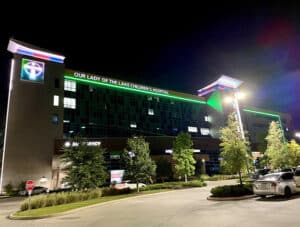When Kandis and John welcomed their son Tucker into the world, everything seemed perfect.
The pregnancy was normal, and Tucker was a healthy baby, hitting all the right milestones. But at 18 months old, something changed.
Tucker started having strange spells — his eyes would roll back, and his body would wobble. Kandis and John recorded these moments, thinking they were just odd baby behavior.
Tucker’s Mimi saw one of the videos and recognized the movements for what they were: seizures. The family took them to his pediatrician right away.
The Start of a Difficult Journey
Initially, Tucker was diagnosed with partial focal seizures, where he would remain somewhat responsive, but his eyes would flutter and roll back. Then an epilepsy DNA panel revealed a positive result for POLG, a mitochondrial disease.
“I remember telling my husband, ‘It’s going to be nothing; we don’t have epilepsy in our family,’” Kandis says. “When the results came back, it threw us for a loop.”
The news was devastating — Tucker’s condition is serious, with a life expectancy limited to childhood.
In September 2021, just before Tucker’s second birthday, Hurricane Ida was battering Louisiana. Tucker woke up in the middle of the night, vomiting and acting strangely.
As his condition worsened, Kandis and John rushed him to Our Lady of the Lake Children’s Hospital in the middle of the storm.
“I remember being on the phone with 911, not sure if he was breathing,” Kandis says. “When we pulled up to the hospital, the nurses were waiting outside to grab him out of the car.” Tucker was admitted to the ICU, fighting for his life as doctors battled to stop his seizures.
A Roller Coaster of Challenges
Just two weeks later, Tucker was back in the hospital with another series of grand mal seizures. This time, the seizures lasted for days. He was placed on a ventilator, and an MRI revealed that he had suffered a stroke in his left thalamus.
“Before he was even awake again, the neurologist told us he wouldn’t be able to move the right side of his body. That was heartbreaking for us,” Kandis says.
Our Lady of the Lake Children’s Hospital coordinated a transfer to a specialty hospital for advanced care for Tucker’s incredibly rare condition.
“That was the most tragic time for us. We were in the hospital for 67 days,” Kandis says. Tucker went to Children’s Hospital New Orleans for rehabilitation, where the family spent nearly 50 days.
Kandis was pregnant with her second child, Josie, at the time, and the timing worked out that she was able to bring both of her babies home together.
There was a one in four chance that Josie could have had the same condition. But an amniocentesis confirmed their daughter is a carrier, as Kandis and John are.
Finding Stability and Hope
Today, Tucker is more stable thanks to a clinical trial in Montreal.
“Do we still have hospitalizations? Yes, but they’re not as dramatic,” Kandis says. “Knock on wood, it’s still scary, but not as bad as it was.”
Despite the challenges, Tucker continues to fight and live life to the fullest. He loves movies, including Inside Out, Luca and Ice Age; playing with his little sister, who often speaks for him; and riding his adaptive bike, a gift from the E.J. Ourso Foundation and McLindon Family Foundation.
Geauxing Green to Raise Awareness
 As Tucker approaches his fifth birthday, his family prepares to celebrate Mitochondrial Disease Awareness Week by wearing green and lighting up landmarks in Baton Rouge, including at Our Lady of the Lake Children’s Hospital.
As Tucker approaches his fifth birthday, his family prepares to celebrate Mitochondrial Disease Awareness Week by wearing green and lighting up landmarks in Baton Rouge, including at Our Lady of the Lake Children’s Hospital.
“Our Lady of the Lake Children’s Hospital has been a lifeline through this journey,” Kandis says. “The doctors and nurses have always been amazing, and we’re so thankful for the care they’ve given Tucker.”
This year Tucker is being honored as one of Our Lady of the Lake’s Geaux Heroes, celebrated for his incredible story of strength and resilience. He is being recognized Sept. 7 at the LSU Football game against Nicholls State University, which is Kandis’ alma mater.




